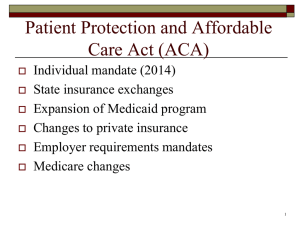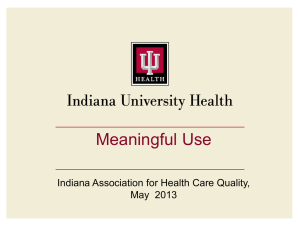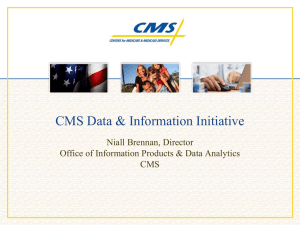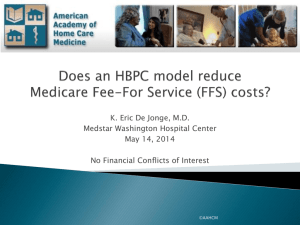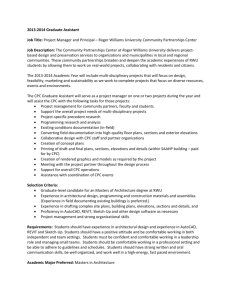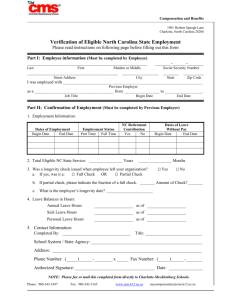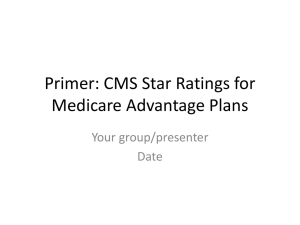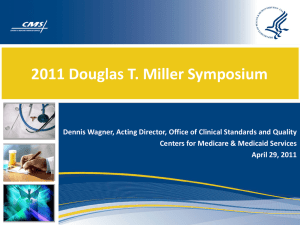Paying for Primary Care: Two CMS/CMMI Payment Experiments
advertisement
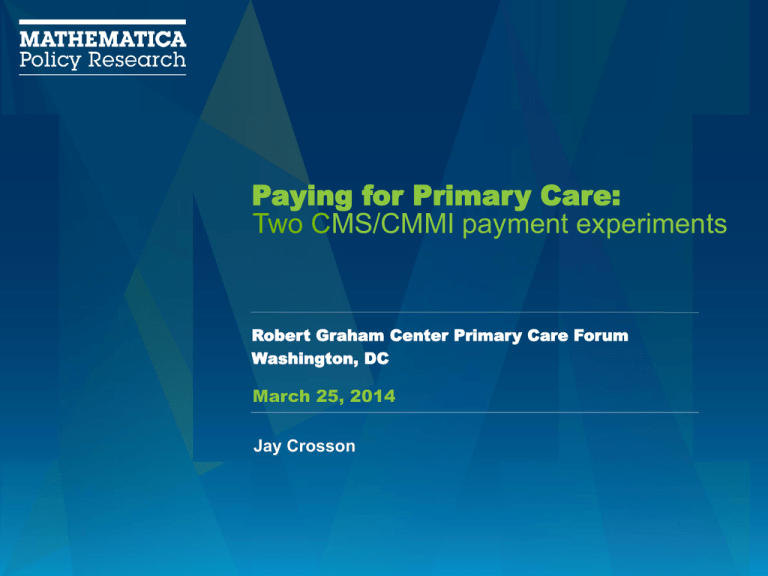
Paying for Primary Care: Two CMS/CMMI payment experiments Robert Graham Center Primary Care Forum Washington, DC March 25, 2014 Jay Crosson The Comprehensive Primary Care Initiative 2 CPC seeks to strengthen primary care • Improve health, lower costs, and improve patient and provider experiences by providing resources to help practices enhance primary care in 5 areas: – Risk-stratified care management – Improved access and continuity of care – Planned care for chronic conditions and preventive care – Patient and caregiver engagement – Coordination of care across the medical neighborhood 3 Organization of the CPC initiative • 4-year multi-payer model launched by CMS in October 2012 to test advanced primary care – 31 payers, ranging from 3 to 9 per region, plus CMS – Provides capital through care-management fees and incentives through shared savings opportunity – Payers share data through feedback reports • 315,000 Medicare patients • Technical assistance and collaborative learning networks • AR, CO, OH/KY, OK, OR, NJ, NY • Evaluation will assess CPC effect on quality, cost, patient wellbeing, practice behavior, and providers, and identify factors associated with success 4 The CPC payment model • Per member/per month payment in the initial stages, regionally-determined shared savings model in later stages – CMS payments average $20 per member/per month – Payments are risk adjusted – Shared savings model – in development 5 CPC learning network and data feedback • Learning and diffusion contractors in each region provide technical assistance to support practice transformation – Webinars – Collaboration website – Learning collaborative meetings – In-person visits • Data feedback to practices – Quarterly reports on Medicare costs and utilization 6 How are practices transforming? • Must meet annual milestones designed to improve care in the 5 functional areas to remain in the program • Budget for and use CPC funding from CMS and other payers to achieve milestones • Practices use resources for: – Risk-stratifying their patient panel – Hiring care coordinators – Improving health IT – Expanding access and office hours – Coordinating care across the medical neighborhood – Assessing and improving patient experience • Too early for estimates of program effects; first annual report out this year 7 The Independence at Home Demonstration 8 IAH tests a home-based primary care model • Mandated by Section 3024 of the Affordable Care Act (P.L. 111-148) • Does home-based primary medical care providing comprehensive, coordinated, continuous and accessible care to high-need populations at home and coordinating care across all treatment settings to improve health outcomes and reduce expenditures for high-risk Medicare beneficiaries: – Reduce preventable hospitalizations – Prevent hospital readmissions – Reduce emergency room visits – Improve health outcomes – Improve efficiency of care – Reduce costs of health care services – Achieve beneficiary and caregiver satisfaction 9 Organization of the IAH demonstration • 15 practices started in June 2012, 3 in September 2012 – Chosen to reflect geographic (15 states and DC), size, affiliation, and care model variation 10 IAH patients • Must… – be entitled to Medicare Part A benefits and be enrolled in Part B benefits – NOT be enrolled in a Medicare Advantage (MA) plan under Part C – NOT be enrolled in a Program of All-inclusive Care for the Elderly (PACE) under SSA Title 18 Sec 1894 – have two or more chronic conditions – have had a hospital admission within the past 12 months – have received acute or subacute rehabilitation services within the past 12 months (including skilled nursing facility, home health, or inpatient and outpatient rehabilitation services) AND – require the assistance of another person (assistance may include supervision, cueing, or hands-on help) for two or more activities of daily living (ADLs) 11 IAH quality measures • Inpatient admissions for ambulatory care sensitive conditions (ACSCs) • Readmissions within 30 days • Emergency department (ED) visits • In-home medication reconciliation • Documentation of patient preferences • Contact with beneficiaries within 48 hours of admission to the hospital and visit within 48 hours after discharge from the hospital or ED. 12 IAH payment model To be eligible for incentive payments, practices must… – Enroll 200 patients – Achieve at least 3 of the 6 Quality Measures • 6 of 6 – eligible for 100% of the incentive payment* • 5 of 6 – eligible for 83% • 4 of 6 – eligible for 67% • 3 of 6 – eligible for 50% – Meet the practice-specific Minimum Savings Requirement (MSR) relative to practice-specific target expenditures • Practices that exceed their specific MSR at the 5% significance level are eligible for payments of up to 80% of the remaining savings – Too early for estimates of program effects; initial report out this year 13 Conclusions • CMS/CMMI experimenting with new payment models as a way to motivate major changes in primary care delivery and outcomes • CMS appears to be moving toward a system that ties new payments for primary care to improved processes and outcomes • Evaluation of results from these initiatives will improve understanding of: – How payment changes affect quality, costs, and patient satisfaction with care – The role of technical assistance and data feedback in supporting change – Which models of primary care support the “triple aim” 14 For More Information • Jay Crosson JCrosson@mathematica-mpr.com 15

